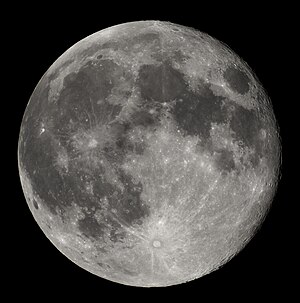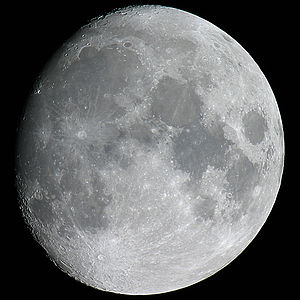 |
| Full Moon (Photo credit: I am marlon) |
 |
| Once in a Very Blue Moon (Photo credit: Wikipedia) |
 |
| Full Moon view from earth In Belgium (Hamois). Français : Pleine Lune vue de la Terre en Belgique à Hamois. (Photo credit: Wikipedia) |
 |
| The waxing gibbous Moon as observed from Earth (Photo credit: Wikipedia) |
 |
| Blue Moon (Photo credit: tonynetone) |
This article is about the astronomical phenomenon. For other uses, see Blue Moon (disambiguation).
A blue moon is the appearance of the third full moon in a season that has four full moons, instead of the usual three.[1] It is never visually blue. Because a blue moon occurs only every two or three years, the term blue moon is used colloquially to mean a rare event, as in the phrase "once in a blue moon"..[2]
One lunation (an average lunar cycle) is 29.53 days. There are 365.26 days in a solar year. Therefore, about 12.37 lunations (365.26 days divided by 29.53 days) occur in a solar year. In the widely used Gregorian calendar, there are 12 months (the word monthis derived from moon) in a year. Each calendar year contains roughly 11 days more than the number of days in 12 lunar cycles. The extra days accumulate, so every two or three years (7 times in the 19-year Metonic cycle), there is an extra full moon. The extra moon necessarily falls in one of the four seasons, giving that season four full moons instead of the usual three, and, hence, a blue moon.
The term blue moon originates in folklore. Different traditions place the extra "blue" full moon at different times.
- The Maine Farmers' Almanac defined a blue moon as an extra full moon in a season. One season was normally three full moons. If a season had four full moons, then the third full moon was called a blue moon.
- In calculating the dates for Lent and Easter, the Christian clergy identified a Lenten moon. Historically, when the moons arrived too early, they called the early moon a betrayer (belewe) moon, so the Lenten moon came at its expected time.
- Folklore named each full moon according to its time of year. A moon that came too early was called a blue moon, so the rest of the moons that year retained their customary seasonal names.
The second full moon in one calendar month is sometimes called a blue moon. This usage results from a misinterpretation, in the March 1946 issue of Sky and Telescope, of the traditional definition of blue moon.[1]





0 التعليقات:
إرسال تعليق